Marine Corps Cpl. Erin Davis performs a pullup in Cleveland, Dec. 17, 2020.
Providing up-to-date information, news and original content on American Military issues.
Sailors on a Mark VI patrol boat heave line during an integrated towing exercise with Coast Guard cutter Oliver Henry in the Philippine Sea, Dec. 16, 2020.
Air Force Staff Sgt. Matthew Mascolo rewards military working dog Bob for finding an explosives odor during an explosives detection certification at Hurlburt Field, Fla., Dec. 16, 2020. Certifications are conducted once a year to ensure each dog team is reliable and ready.
Marine Corps recruits practice martial arts techniques at Marine Corps Recruit Training Depot Parris Island, S.C., Dec. 17, 2020.
Dec. 18, 2020 | BY Jim Garamone , DOD News
Miller signed a memo entitled "Actions to Improve Racial and Ethnic Diversity and Inclusion in the U.S. Military" that examined the culture of the military following the murder of George Floyd in Minneapolis.
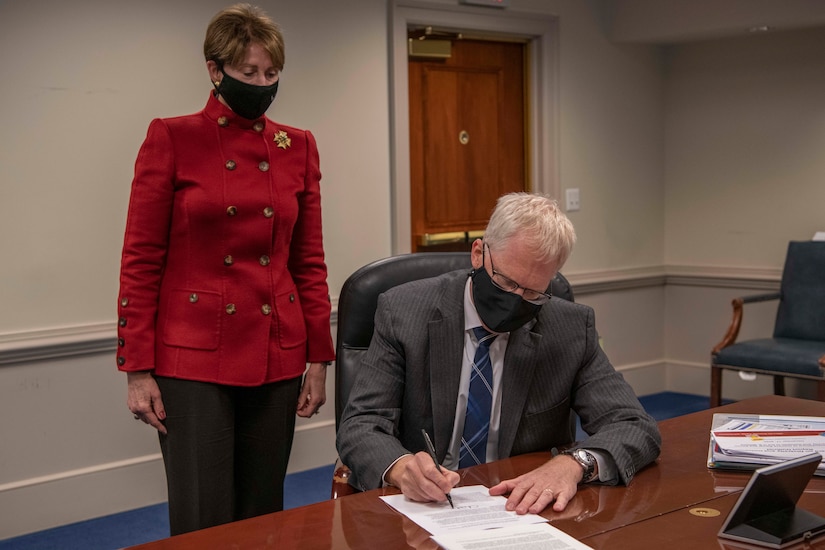
In the memo, Miller called diversity and inclusion in the DOD "moral imperatives." Miller — and Esper — stressed the need for all service members to be treated with dignity and respect. Service members from different backgrounds and cultures bring a wealth of experiences to the U.S. military and that needs to be encouraged.
"To strengthen diversity and inclusion across the Department of Defense, the Board analyzed data, reviewed literature, crowdsourced feedback, and listened to personal experiences," Air Force Secretary Barbara Barrett, who chaired the board, said. "Our analysis generated 15 recommendations to empower each individual to fulfill his or her maximum potential."
Senior Enlisted Advisor to the Chairman of the Joint Chiefs of Staff Ramón "CZ" Colón-López and Matthew Donovan, the undersecretary of defense for personnel and readiness, assisted Barrett. The board, which included representatives from all services, evaluated military diversity and inclusion policies, programs and processes; reviewed industry best practices; and assessed pertinent data and reports, DOD officials said.
The first recommendation is for military recruiting content to reflect the current and future racial, ethnic and gender demographics of the United States.
The second recommendation deals with the dearth of diversity at the higher levels of the military. The recommendation calls for the department to develop a data-driven accessions and retention strategy. The deadline for the DOD to develop this strategy is March 31.
The third recommendation looks to increase the diversity of the officer corps itself. It recommends the DOD expand sponsorship of programs and initiatives to increase the available pool of qualified applicants for ROTC enrollments, scholarships and commissions from students enrolled at minority-serving institutions. These institutions include historically Black colleges and universities, Hispanic-serving institutions, tribal colleges and universities, and institutions serving Asian Americans and Pacific Islanders.
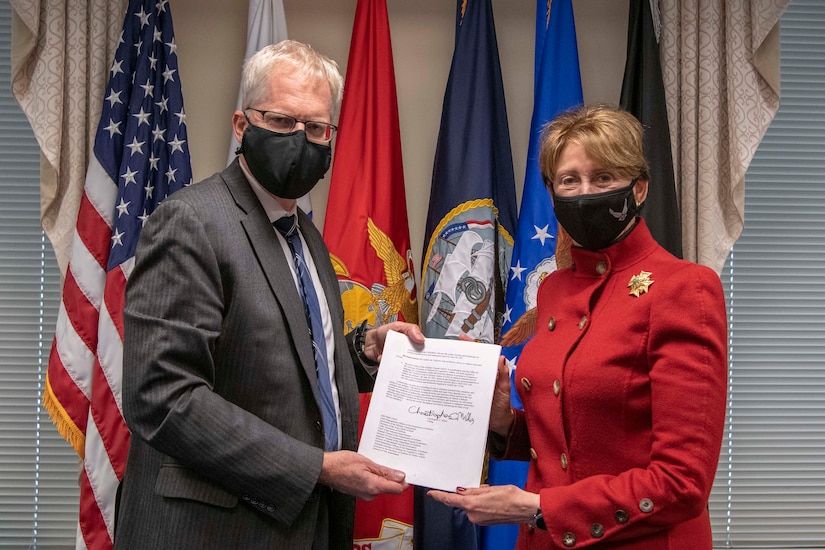
The board calls for a thorough review of DOD aptitude tests to ensure they do not adversely impact diversity. The DOD will develop plans for a rigorous and thorough assessment of all aptitude tests currently administered. The goal of this assessment will be to analyze, identify and remove — as applicable — "barriers that adversely impact diversity while retaining rigorous screening processes necessary to access a high-quality force," the board recommendation states.
The board also wants the military to evaluate demographic trends in performance evaluations.
The DOD is also looking to provide diverse pools for nominative positions. These positions are often the road to senior ranks in the department. The board wants to ensure all service members are represented.
The board also wants the department to:
The board also recommends prohibiting all extremist or hate-group activities. While this is already the case, the board wants the DOD to look to ways to strengthen the prohibitions against extremist or hate group activity.
In conjunction with this, the board wants to update the Uniform Code of Military Justice to address extremist activity.
"The board's recommendations, and the department's measures to implement them, are important and positive steps toward ensuring diversity and inclusion. However, enduring culture change requires commitment from every level of leadership and from every individual service member to capitalize on this momentum. Success requires constant vigilance. These recommendations start us off, but our dedication to this on a force-wide scale will ensure we achieve our end-goal of a more diverse and fully inclusive force," Dr. Elizabeth P. Van Winkle, executive director of the Office of Force Resiliency for the undersecretary of defense for personnel and readiness, said.
"Collectively, we must do everything we can to eliminate potential bias, prejudice and racism in our military," Miller wrote. "Our ability to maintain a lethal and ready force depends on it. I am confident these actions will bolster existing diversity and inclusion efforts and pave the way towards new methods of enhancing opportunity and strengthening our nation's defense."
Marines take part in Exercise Steel Knight 21 in Twentynine Palms, Calif., Dec. 4, 2020. The exercise provides Marines and sailors training in maneuver warfare tactics and command and control capabilities across a wide range of environments.
With this solicitation, NIJ, in collaboration with the Office of Juvenile Justice and Delinquency Prevention, seeks proposals for rigorous research projects that improve measurement of juvenile reoffending. NIJ encourages applicants to submit proposals for studies that advance knowledge and understanding of juvenile reoffending and aid jurisdictions and juvenile justice agencies in measuring and using juvenile reoffending data appropriately in their efforts to identify priorities, develop responses, and monitor and assess policies and programs.
In FY 2021, applications will be submitted in a new two-step process, each with its own deadline:
APPLY NOWApplicants must register with Grants.gov and register with JustGrants prior to submitting an application. This solicitation is competitive; therefore, NIJ staff cannot have individual conversations with prospective applicants. Any questions concerning the solicitation should be submitted to the National Criminal Justice Reference Service: 1-800-851-3420; TTY at 301-240-6310 (for hearing impaired only); email; fax 301-240-5830; or web chat. See also NIJ.gov's solicitation FAQ page. The following application elements MUST be included in the application submission for an application to meet the basic minimum requirements to advance to peer review and receive consideration for funding: Program Narrative, Budget Worksheet and Budget Narrative, and resumes/curriculum vitae of key personnel. Make sure to also go over the application checklist provided in the solicitation before submitting. |
Army Spc. Kevin Piepenbrink records firing points during a live-fire exercise in Djibouti, Dec. 16, 2020.
Dec. 18, 2020
Today, Acting Secretary of Defense Christopher C. Miller announces the release of the Department of Defense Board on Diversity and Inclusion Report, “Recommendations to Improve Racial and Ethnic Diversity and Inclusion in the U.S. Military”, and its resulting implementation plan.
“The Diversity and Inclusion board reviewed recommendations from various team members across the Department’s total force and, ultimately, provided recommendations to the Acting Secretary intended to bolster the Department’s diversity and inclusion efforts. The most effective fighting force necessitates inclusion and full engagement of all Department assets—foremost, every member of the Total Force. Diversity and inclusion make us a stronger, better and more effective military.” said Jonathan Hoffman, Chief Pentagon Spokesperson.
On July 15, 2020, the DoD Board on Diversity and Inclusion embarked on the important task of identifying recommendations to improve the Department's diversity and inclusion and broaden equal opportunity for all members of the Armed Forces. Chaired by the Secretary of the Air Force, with the support of the Senior Enlisted Advisor to the Chairman of the Joint Chiefs of Staff and the Under Secretary of Defense for Personnel and Readiness, and Service members from each branch of the Military Services and the National Guard Bureau, the Board evaluated military diversity and inclusion policies, programs, and processes; reviewed industry best practices; and assessed pertinent data and reports.
This effort culminated in the Department of Defense Board on Diversity and Inclusion Report: Recommendations to Improve Racial and Ethnic Diversity and Inclusion in the US Military.
The 15 recommendations are as follows:
Following the review of the 15 recommendations from the Board, the Acting Secretary directed specific actions towards the complete implementation of each of the recommendations.
The Department of Defense Board on Diversity and Inclusion Report: Recommendations to Improve Racial and Ethnic Diversity and Inclusion in the U.S. Military can be found here.
The memo on Actions to Improve Racial and Ethnic Diversity and Inclusion in the U.S. Military, dated Dec. 17, 2020, can be found here.
Dec. 18, 2020 | BY David Vergun , DOD News
The strategy details partnerships across federal agencies designed to mitigate global conflict and promote stability and prosperity. The Global Fragility Act of 2019 directed the State Department to lead this whole-of-government strategy.
Stephanie Hammond, acting deputy assistant secretary of defense for stability and humanitarian affairs, said this strategy aims to prevent conflict and promote stability by focusing on interagency collaboration and fostering strong partnerships.

One of the main tools to support the interagency effort and implementation of the strategy, she said, is DOD's interagency support authority — known as the Defense Support to Stabilization.
This new authority allows DOD to provide logistical support, supplies and services to other federal agencies conducting stabilization activities, she said.
Defense support to stabilization ensures critical civilian expertise can get into hard-to-reach areas more quickly and efficiently and with more effective resources, creating a unity of effort that the agencies have lacked in the past, Hammond said.
This strategy looks to a complex future challenged by both regional and world powers, and allows the United States to work with a united front and build strong coalitions with civil society, think tanks, academia and international partners to meet the most difficult tasks, she said.
"I believe this strategy will end up and serve as a foundational document for many years," she added.
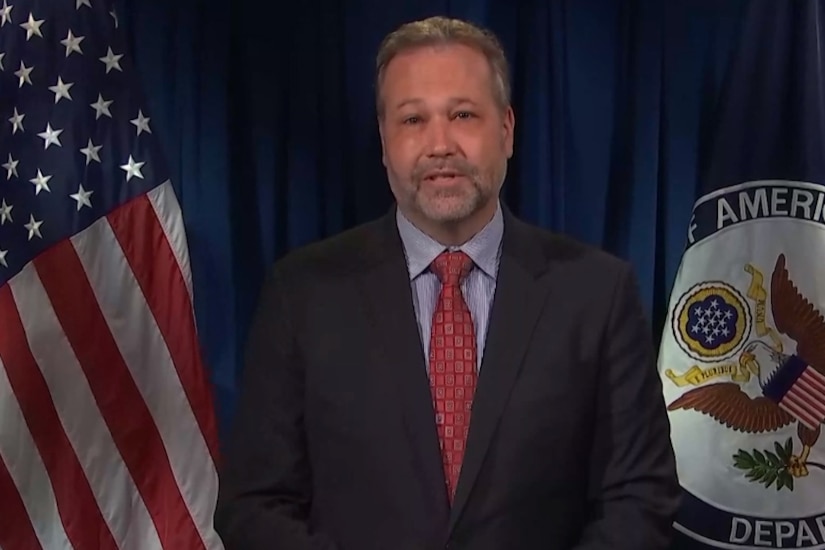
Jim Richardson, director of the Office of Foreign Assistance at the State Department, spoke about some of the shortcomings that led to the need for this strategy.
"Within the past five years, the U.S. has spent about $30 billion in foreign assistance in just the 15 most fragile countries," he said. "We're not alone. Nearly every donor around the world is doubling down in these spaces for a simple reason: weak and poorly governed states give rise to a host of challenges — including conflict, terrorism, crime and humanitarian crises."
"These challenges can also spill across borders, threaten regional and even global peace, as well as our own national security," he added.
Unfortunately, even with high levels of investments from the U.S. and other countries, progress has not been adequate, he said.
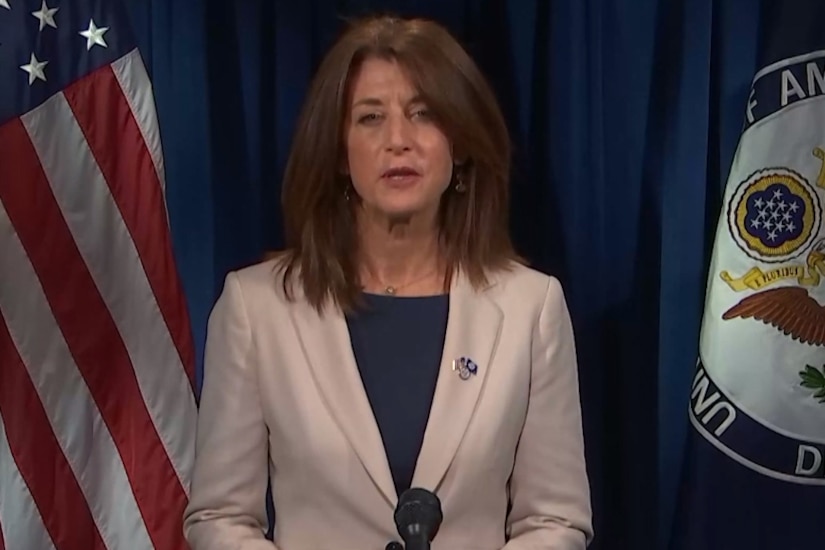
Dr. Denise Natali, assistant secretary of state for conflict and stabilization operations, said "the strategy is not old wine in a new bottle."
Rather than externally driven nation-building, the United States will support locally driven solutions that align with U.S. national security interests rather than fragmented and broad-based efforts, the United States will target the political factors that drive fragility. And rather than diffuse and open-ended efforts, the United States will engage selectively, based on measurable results, host-country political will, respect for democracy and human rights and cost sharing, Natali said.
Stephen Biegun, deputy secretary of state, said, "Our strategy reflects input from a broad range of experts and draws on lessons learned from decades of experience."
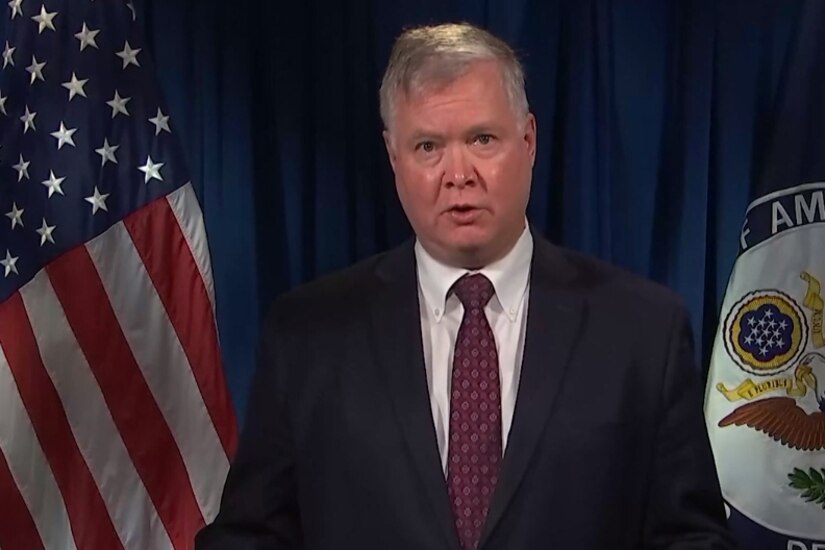
He added that the strategy, along with the Global Fragility Act of 2019, has had strong bipartisan support from Congress.
Other speakers included: Robert Jenkins, deputy assistant administrator for conflict prevention and stabilization at the U.S. Agency for International Development; Mathew Haarsager, deputy assistant secretary of international development, finance and policy at the Treasury Department; and Tjada D'Oyen McKenna, chief executive officer of Mercy Corps.
Dec. 18, 2020 | BY Jim Garamone , DOD News
Chairman of the Joint Chiefs of Staff Army Gen. Mark Milley inducted Raymond, the chief of space operations, into the Joint Chiefs of Staff at a ceremony on Dec. 11. He becomes an official member of the body on the same day the Space Force celebrates its first anniversary as an official service branch.
The law stated that the chief of space operations would become a member of the Joint Chiefs a year after it was signed. "But under your leadership and under [the] leadership [of] the vice chairman, you said 'We're not going to wait!,' and you've treated me like a member ever since [the law was signed]," Raymond said during the ceremony at the Pentagon. "I can't thank you enough. I can't thank my teammates enough. It's a real privilege to sit at this table."
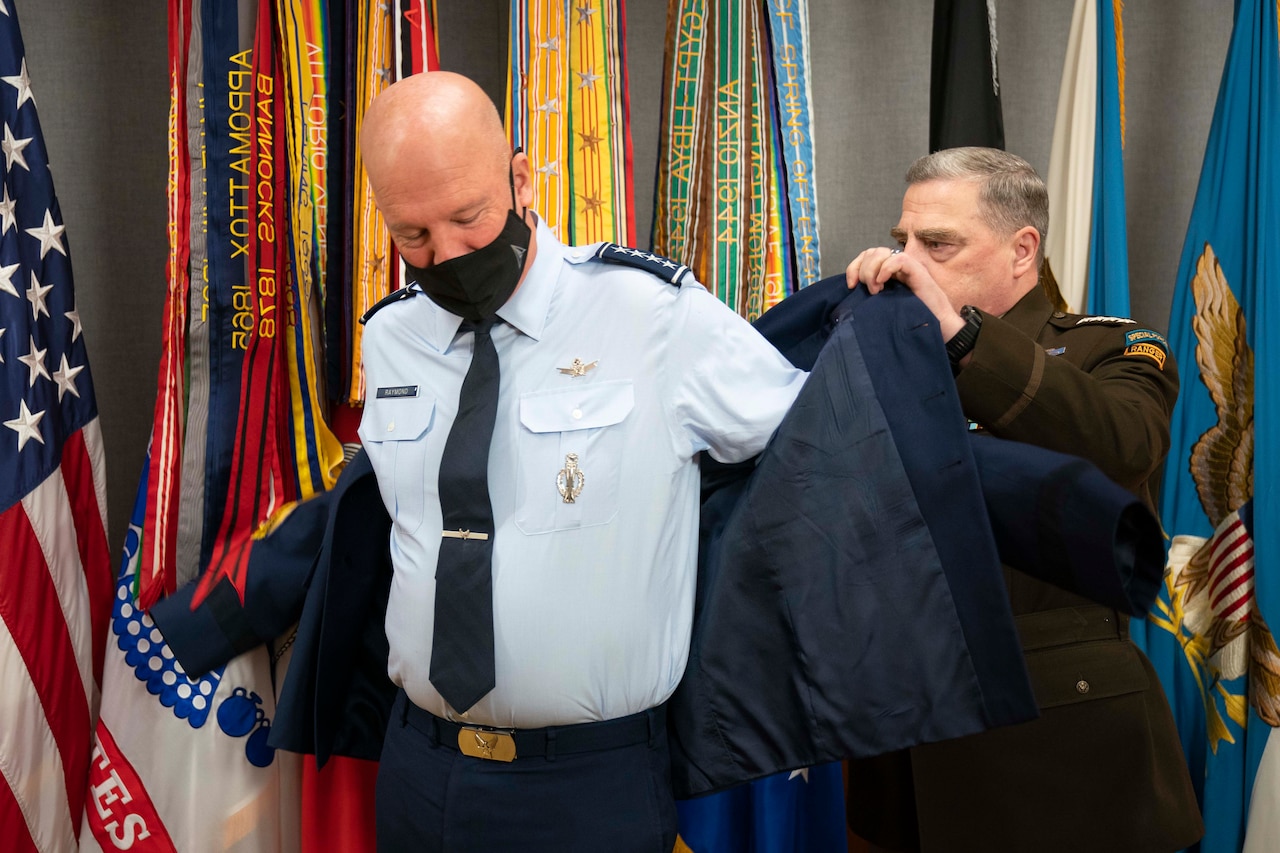
The induction of Raymond points to the growing importance of space in American life. It also highlights the increased importance of the domain to the military. "We recognize it clearly as a warfighting domain. And we also know that we, the United States, we've got to maintain capabilities in that domain if we are going to continue to deter great power war," Milley said during the ceremony. "This is an incredibly important organization for the United States military and for the United States as a country. And it's really important what we're doing today, which is [to] induct you as an official member into the Joint Chiefs of Staff."
The United States Space Force is a separate service under the Department of the Air Force. It will grow to about 20,000 members with most coming from the Air Force, but with other services also providing personnel. The Air Force will provide all the services the new force needs, allowing the space professionals to concentrate on their missions.
"How fitting: The Chief of Space Operations is now officially a member of the Joint Chiefs of Staff, in keeping with the pivotal role of space in national defense," said Air Force Secretary Barbara Barrett. "Incomparable Gen. Jay Raymond is building an agile, innovative and bold Space Force. With the other chiefs, Gen. Raymond will offer his best military advice to the president, National Security Council, Homeland Security Council and defense secretary as they implement the National Defense Strategy."
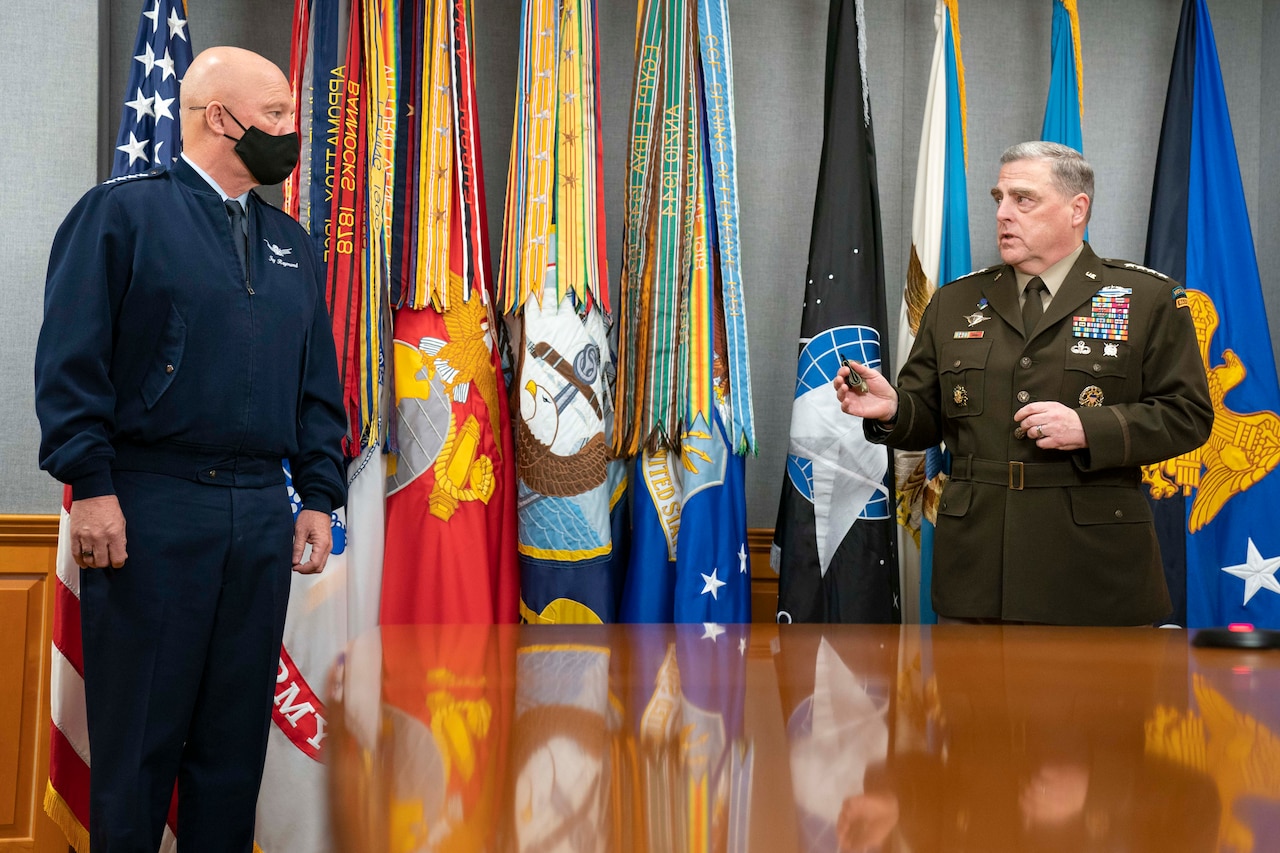
Membership on the Joint Chiefs of Staff is set by law. The members are the chairman of the Joint Chiefs of Staff, the vice chairman, the Army chief of staff, the commandant of the Marine Corps, the chief of naval operations, the Air Force chief of staff, the chief of the National Guard Bureau and, now, the chief of space operations.
The body has grown and changed since it was formed out of the destruction of World War II. When formed, the Joint Chiefs were the chairman, the Army chief of staff, the chief of naval operations and the Air Force chief. The commandant of the Marine Corps was included when issues pertaining to the Marine Corps were discussed by the chiefs but he was not a member of the Joint Chiefs of Staff, said David Crist, Joint Staff historian.
Through the Berlin blockade, the Korean War, the Cuban Missile Crisis of October 1962, the Vietnam War and its aftermath, the body remained the same. The first personnel change came in 1978 when the Marine Corps commandant became a full-fledged member of the body.
In 1986, came the Goldwater-Nichols Act. It would be hard to understate the legislation's effects on the Joint Chiefs of Staff. The legislation increased the visibility, responsibilities and reach of the chairman and added the office of the vice chairman of the Joint Chiefs of Staff. It changed the way the Joint Staff was manned and stressed the importance of joint duty for military officers and personnel.
The next change in the make-up of the body was the inclusion of the chief of the National Guard Bureau in 2012.
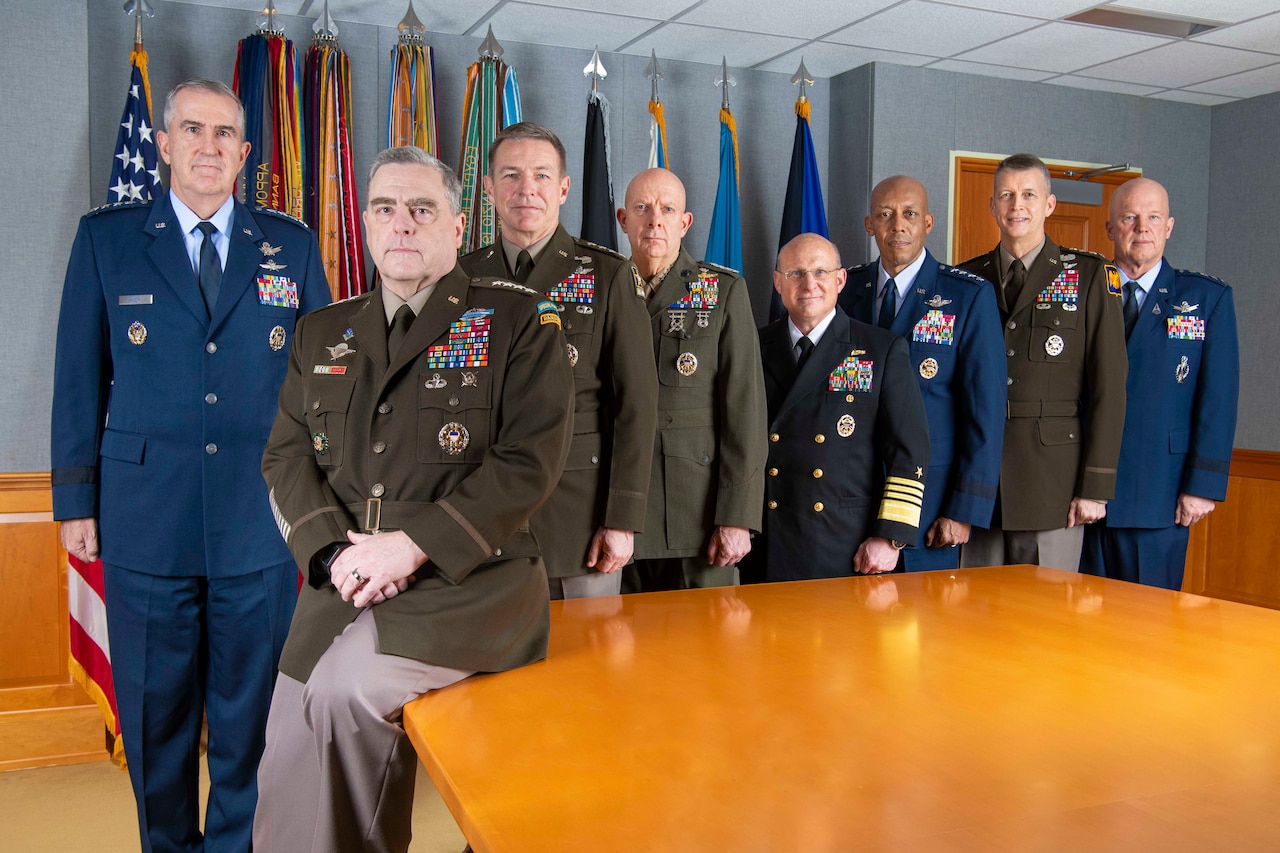
With the creation of the Space Force, comes the newest change.
Each chairman uses the body a bit differently, Crist said. The most recent three chairmen — Army Gen. Martin E. Dempsey, Marine Corps Gen. Joe Dunford and current chairman Army Gen. Mark A. Milley — convened the chiefs regularly for deliberations on many issues, Crist said.
This is not to say the Joint Chiefs is a consensus organization. The chairman decides what the best military advice is for the defense secretary, president and the rest of the National Security Council. Still, the chairman can — and does — pass along dissenting opinions from the other members of the Joint Chiefs when appropriate.
The Army, Marine Corps, Navy, Air Force and Space Force members of the joint chiefs are responsible for manning, training and equipping forces. But when they enter "the Tank" — the room in the Pentagon where they convene — they are expected to think and act for the good of the joint force. Their experience as a soldier, Marine, sailor or airman may color their perspective, but as members of the JCS, they are expected to embrace the larger military culture, Crist said.
Dec. 18, 2020 | BY Navy Petty Officer 3rd Class Jacob L. Greenberg
Naval Medical Center San Diego received its first shipment of coronavirus (COVID-19) vaccines Dec. 14, 2020. The vaccines are from the American pharmaceutical corporation Pfizer and are administered in a two-dose series.
"I'm very excited and proud that NMCSD is among the first [COVID-19] vaccine sites in the world," said Navy Cmdr. Jason Rice, NMCSD's director of public health and public health emergency officer. "I'm grateful that we have the opportunity to participate in such a historic public health event that will have a profound impact on the health of our staff and the Department of Defense family we serve.
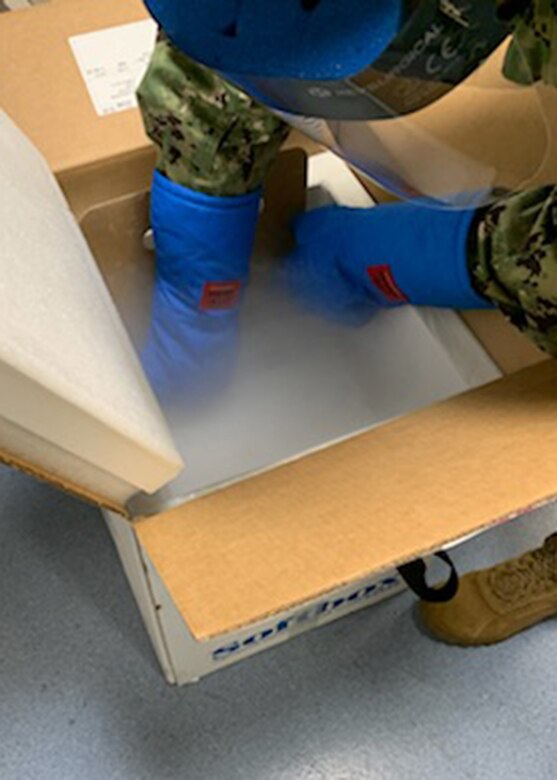
The DOD COVID-19 vaccine distribution and administration plan will implement a phased, standardized and coordinated strategy for prioritizing, distributing and administering COVID-19 vaccines to protect our people, maintain readiness and support the national COVID-19 response. The Department of Health and Human Services and Centers for Disease Control and Prevention vaccine allocation data have informed the deliberate development of the DOD's feasible and scalable distribution and administration plan.
"For several weeks, our public health and material management teams have been working very hard to prepare for this event to ensure that we would be able to safely and effectively receive, store, handle and administer the vaccine," Rice said. "It has certainly been a challenge, given the unique requirements of this particular vaccine and the compressed timeline for its rollout. Our team has done an outstanding job in preparing to execute this mission, and we're excited to be a part of this critical, public health response effort."
NMCSD is coordinating with regional installation leadership to vaccinate volunteering first responders, such as frontline health care workers, emergency management service personnel and security forces.
"Now that we have successfully received the vaccine, we will begin administering it on Dec. 15," Rice said. "In this phase we are prioritizing our highest-risk health care workers and first responders from our local installations. Within phase 1, there are three sub-tiers. Sub-tier 1 consists of health care workers within the emergency department and intensive care unit, as well as local installation emergency medical services, fire and police departments from the six local Navy and Marine Corps installations that we support. Sub-tier 2 recipients include our NMCSD inpatient health care workers, and sub-tier 3 are their outpatient counterparts."
Rice said when NMCSD begins administering the vaccine, they will work to vaccinate sub-tier 1 personnel within 2-3 days, followed by sub-tier 2 and 3 personnel as vaccine supplies from this initial shipment permit.
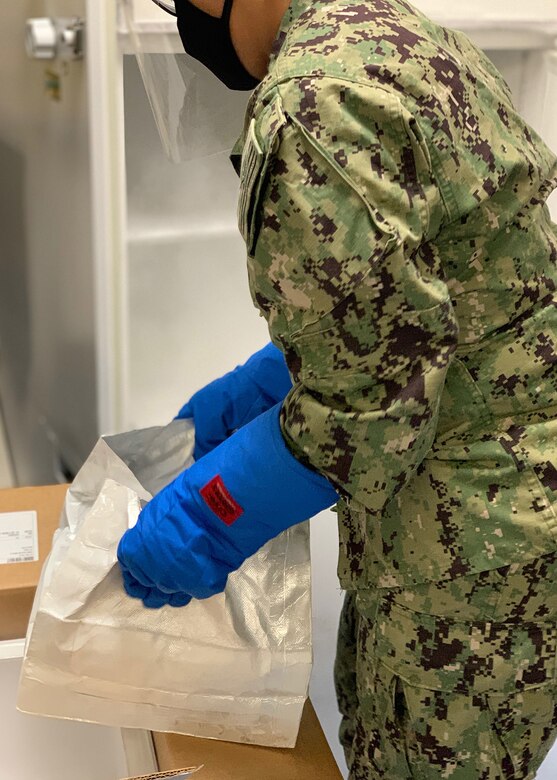
The implementation of phase 2 will begin when NMCSD receives its next shipment of vaccines from Pfizer.
"We anticipate that shipment arriving in the coming weeks," Rice said. "[That shipment will] cover the second dose for everyone who received their first dose this week, and with the remainder, we will move on to administering dose number one for additional healthcare workers."
The general reception of the vaccine around NMCSD has been positive.
"From my discussion with staff members throughout the command, including talks with leadership all the way down to the deck plates, my sense is that our staff are very receptive and excited about receiving the vaccine," Rice said. "As with any new vaccine or therapeutic that comes out, there will be some confusion and many questions; that is expected. We will have staff on hand to counsel patients and address their questions and concerns."
Rice said, “NMCSD will subsequently move on to vaccinating all active duty and eligible beneficiaries as per the DOD's prioritization schema. When NMCSD moves on to that phase of the rollout, our goal is to ensure that all beneficiaries are well informed about the vaccine. We look forward to continuing the process, beginning with our phase 1 health care providers, moving on to our supported active duty units as well as all of our beneficiaries."
NMCSD is committed to protecting the health and readiness of our sailors, Marines, civilian employees and their families, safeguarding our national security capabilities, and supporting the whole-of nation response. All DOD personnel will continue to wear appropriate face masks, practice physical distancing, wash hands and follow restriction of movement guidelines to protect themselves.
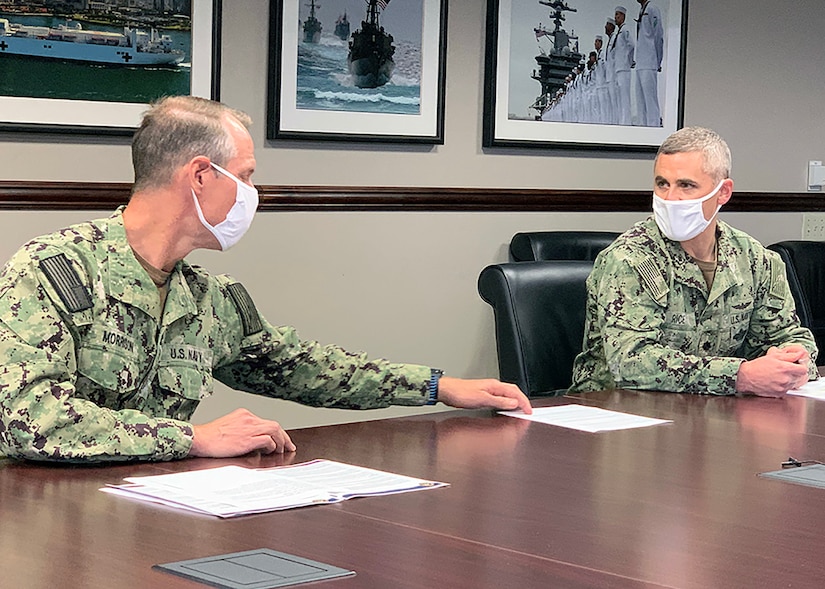
NMCSD and Naval Hospital Camp Pendleton were selected by the DOD's COVID-19 Task Force to receive the first doses of Pfizer's COVID-19 vaccine, based on recommendations from the military services and the U.S. Coast Guard, to best support several criteria to include anticipated supply chain requirements, such as cold and bulk storage facilities, local population of at least 1,000 priority personnel across the military services and sufficient medical personnel to administer vaccines and actively monitor vaccine recipients.
NMCSD's mission is to prepare service members to deploy in support of operational forces, deliver high quality health care services and shape the future of military medicine through education, training and research. NMCSD employs more than 6,000 active duty military personnel, civilians and contractors in Southern California to provide patients with world-class care anytime, anywhere.
Army Spc. John Deseo,assigned to the Guam National Guard's Task Force Response, assists with traffic flow on the island's first day of COVID-19 vaccine administration in Dededo, Guam, Dec. 17, 2020.
The USS Constitution displays holiday lights and decorations during a snowstorm while moored to the pier at the Charlestown Navy Yard in Boston, Dec. 17, 2020. First launched in 1797, the USS Constitution is the world’s oldest commissioned warship afloat.
May Oliva, a clinical nurse assigned to Naval Medical Center San Diego, administers a nasopharyngeal swab to test a patient for the coronavirus during a trial for AstraZeneca’s candidate for the COVID-19 vaccine, Dec. 17, 2020. The trial is part of Operation Warp Speed, a national initiative to accelerate the development, production and distribution of COVID-19 vaccines, therapeutics and diagnostics.
Marines provide security in a snowstorm during Exercise Forest Light 21 in the Niigata Prefecture, Japan, Dec. 16, 2020. Forest Light is an annual bilateral training exercise that strengthens the interoperability and readiness of the Marine Corps and the Japan Ground Self-Defense Force.
Marine Corps Lance Cpl. Jerren Strong covers his face with camo paint in preparation for a simulated boat raid at Kin Red, Okinawa, Japan, Dec. 16, 2020. The Marines conducted the raid in the dark to enhance proficiency for night operations.
Dec. 18, 2020
Statement by Acting Secretary of Defense Miller:
The Department of Defense will continue to provide all required support to the Agency Review Team (ART) to keep our nation and her citizens safe. As of today, we have supported 139 interviews sessions more than 200 DoD personnel, 161 requests for information, and disclosed thousands of pages of non-public and classified documents, exceeding prior transitions. At no time has the Department cancelled or declined any interview.
Our key focus in the next two weeks is supporting essential requests for information on OWS and COVID-19 information to guarantee a flawless transition. This is my major focus area.
After the mutually-agreed upon holiday pause, which begins tomorrow, we will continue with the transition and rescheduled meetings from today.
Again, I remain committed to a full and transparent transition – this is what our nation expects and the DoD will deliver AS IT ALWAYS HAS.”
TRANSITION FACTS
To date, since November 23rd the Department has:
• Conducted 139 interviews with 265 officials
• Responded to 161 requests for information (RFI)
• Provided 4,400 pages of controlled non-public information
• Provided 900 pages of classified information
We continue to schedule interviews with senior leaders and career officials. Today, we are working to reschedule approximately 20 interviews with 40 officials until after January 1.
We continue to support with:
• Reading materials,
• reporting requirements,
• and working with the Agency Review Team to validate a pilot for rapidly onboarding political appointees in a new administration.
This has all been done while:
• taking all precautions to protect American lives from COVID-19 exposure
o Operating under HPCON B – with only 40% of the workforce in the building and 60% teleworking.
o Conducting all interviews virtually – something that has never been done before.
• Implementing the National Defense Strategy
• Supporting Operation Warp Speed to save American lives.
DoD continues to support the presidential transition aligned with the President Transition Act, White House and Biden-Harris Transition Team Memorandum of Understanding, and DoD policy.
In 2016, a total of approximately 175 RFIs were responded to and 180 interviews were conducted from November 19th through January 12th. Most of these interviews were with junior career officials, not senior leaders. Implementing guidance from the Secretary, DoD has made available leaders at the highest levels of our organization, many senate-confirmed as well as other politically appointed leaders, and has ensured senior career officials and experts were also part of the interview process.
New York National Guard Army Maj. Stephen Carson prepares the COVID-19 vaccination area at the Camp Smith Training Site Medical Readiness Clinic in Cortlandt Manor, N.Y., Dec. 16, 2020. The New York National Guard is participating in a Defense Department vaccine pilot program in which 44,000 doses of the Pfizer vaccine are being administered to frontline medical personnel at 16 locations around the world.